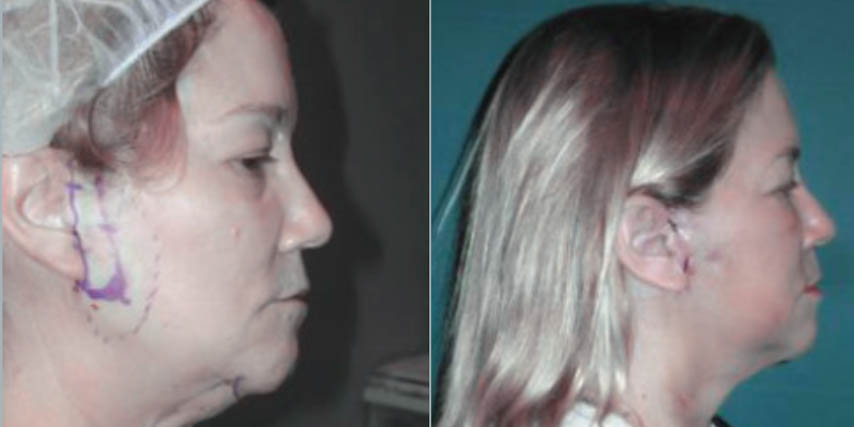MINIMALLY INVASIVE FACELIFT
Mini lifts are targeted procedures that produce a natural-looking, more youthful appearance, and are completely customizable for every patient. Mini facelifts allow quicker recovery time and long-lasting results at a lower cost and can help your achieve your rejuvenation goals.

MINIMALLY INVASIVE FACELIFT
Mini lifts are targeted procedures that produce a natural-looking, more youthful appearance, and are completely customizable for every patient. Mini facelifts allow quicker recovery time and long-lasting results at a lower cost and can help your achieve your rejuvenation goals.
Request Your Consultation

Why you should consider minimally invasive facelift
A minimally invasive facelift, also known as a lateral facelift, weekend lift, or lifestyle lift, is a less invasive version of a traditional facelift. Minimally invasive facelifts are ideal for men and women looking to reduce the appearance of loose or sagging skin and wrinkles. For patients with neck, jawline, and or cheek laxity, a minimally invasive facelift can be a great option and an ideal alternative to a traditional facelift. Our patients often combine the minimally invasive facelift treatment with other procedures like fat grafts and dermal fillers. FaceTite™, which uses radiofrequency assisted lipolysis to tighten the skin up to 36 percent, can also be used in conjunction with a minimally invasive facelift procedure.


Advantages of a Minimally Invasive Facelift
A minimally invasive facelift is an alternative to surgery and offers patients the following benefits:
- Short procedure time– Minimally invasive facelifts are performed in our office under local anesthesia and typically take only 30 to 60 minutes.
- Minimal downtime– Patients are able to drive home after their procedure. Healing takes approximately one week for most patients.
- Small incisions– The incisions are placed under the chin and behind the earlobe to minimize scarring and detection. The scars are often covered by your hair as you heal.
- Long lasting results– The results of a minimally invasive facelift are long-lasting.
- Immediate results – The results of a minimally invasive facelift can be seen immediately and will improve as the swelling subsides over the course of one to two weeks post-surgery.
- Cost–When compared to a traditional facelift, a minimally invasive facelift is often less expensive.
What is the difference?
Traditional facelift surgery removes excess skin, lifts deep tissues, and tightens muscles. It is very effective, but a full face and neck lift requires sutures, and approximately four weeks of downtime.
A mini facelift is a modified version of a traditional facelift. In the “mini” version, a plastic surgeon uses small incisions around your hairline to help lift the lower half of your face to help correct sagging skin.
Despite its name, a mini facelift is still a major cosmetic procedure. It’s important to weigh all the benefits versus the costs and risks before undergoing any type of cosmetic surgery.
How does a mini facelift work?
A mini facelift is an anti-aging surgery that focuses on sagging skin. Cosmetic surgeons address this by “lifting” your skin upwards via small incisions.
They’ll also remove excess skin during the process, which can in turn help tighten your skin and reduce the appearance of wrinkles.
Sometimes an eye lift or brow lift is also done in conjunction with a mini facelift to help maximize your results. This is because facelifts only target the lower half of your face — mainly your jawline and cheeks.
Neck Lifts
As an invasive surgery, a mini facelift requires either general or local anesthesia. Once you’re under anesthesia, your surgeon will make small incisions around your ears and hairline.
They’ll manipulate the underlying tissues in your skin by lifting and then pulling them up, while also remove excess tissue.
Once the surgery is complete, your surgeon will use sutures to close up all incisions.
Targeted areas for a mini facelift
Unlike a traditional facelift, a mini facelift is conducted via smaller incisions. These are usually made along your hairline or above each of your ears. Your surgeon then pulls your skin tissues upward through the cheeks to help correct sagging skin.
The smaller incisions used in a mini facelift can be especially helpful if you’re prone to scarring.
Mini facelift vs. nonsurgical procedures
A mini facelift doesn’t involve as many incisions as a full facelift, but it’s still an invasive procedure. Like any type of surgery, it can carry the risk of bleeding, infection, and scarring.
Depending on your overall goals and health, a nonsurgical procedure might be more appropriate. This is especially the case if you’re more concerned about overall volume and texture compared to sagginess.
What to Expect on the Day of Your Minimally Invasive Facelift Treatment
Upon arrival, your doctor will numb the areas where the incisions will be placed. After making an incision behind the earlobe or under the chin, your skin will be pulled back and sutured into place. At this time any complimentary procedures, like FaceTite™, will also be performed. It is common to experience minimal discomfort during the procedure, but it is not painful. After the incisions are closed up, you will be able to drive yourself home. There will be a need for several follow-up appointments to monitor the progress of your healing. The majority of our patients return to work in approximately one week.
Quick Facts about Mini Lifts
What is it?
A mini facelift is a corrective cosmetic procedure that targets sagging skin. By focusing on the lower half of the face, the overall goal of this procedure is to help correct sagging skin around the neck and jawline.
Is it safe?
While a mini facelift uses fewer incisions compared to a traditional facelift, it’s still considered an invasive procedure. Like all types of surgery, mild side effects are to be expected. These include bruising, pain, and swelling. Severe side effects are rare but may include excessive bleeding and infections.
Is it effective?
Overall, a mini facelift is considered effective in correcting sagging skin in the lower half of your face. Depending on your overall goals, you may consider additional procedures, such as an eye lift or dermal fillers.






Request Your Consultation Today with Joseph Perlman, MD
For patients located in Spring, Houston, The Woodlands, Atascocita, Conroe, Pasadena, Baytown, and surrounding areas in Texas who are looking to learn more about minimally invasive facelifts we invite you to contact us to schedule a personal consultation.
FAQ on Minimally Invasive and Mini Facelift Procedures
A minimally invasive facelift is a surgical procedure designed to rejuvenate the face with less extensive surgery than a traditional facelift. It typically involves smaller incisions, less tissue disruption, and a quicker recovery time while still providing noticeable improvements in facial contours.
A mini facelift in Houston is a type of facelift that targets the lower face and jawline. It involves smaller incisions and less extensive surgery compared to a traditional facelift, making it ideal for patients with mild to moderate signs of aging who want a quicker recovery.
A non-invasive facelift in Houston offers benefits such as minimal downtime, no surgical incisions, and reduced risk of complications. Techniques may include ultrasound, radiofrequency, or laser treatments to tighten and lift the skin, providing a more youthful appearance without surgery.
From a Houston mini facelift, you can expect a subtle yet effective improvement in the lower face and jawline. The procedure typically results in reduced sagging and smoother skin with a faster recovery time compared to traditional facelift surgery.
A mini neck lift in Houston is a surgical procedure designed to address sagging skin and excess fat in the neck area. It involves smaller incisions and less recovery time than a full neck lift, making it an attractive option for patients seeking a less invasive approach.
The cost of a mini face lift in Houston can vary depending on factors such as the surgeon’s experience, the specifics of the procedure, and associated fees. On average, patients can expect to pay between $3,500 and $8,000.
Minimally invasive procedures near The Woodlands include options like Botox, dermal fillers, laser resurfacing, microneedling, and chemical peels. These treatments aim to improve the appearance of the skin with minimal downtime and fewer risks compared to surgical procedures.
A good candidate for a mini face lift in Houston is someone with mild to moderate signs of aging in the lower face and jawline, who is in good overall health, and has realistic expectations about the outcomes. A consultation with a qualified plastic surgeon can help determine if a mini facelift is right for you.
Preparation for a minimally invasive facelift involves a thorough medical evaluation, possibly adjusting or discontinuing certain medications, avoiding smoking, and arranging for post-procedure care. Your surgeon will provide specific instructions tailored to your needs.
The recovery process for a mini facelift typically involves some swelling, bruising, and discomfort, which can be managed with prescribed medications. Most patients can return to normal activities within a week or two, but it may take several weeks for all swelling to subside and final results to become apparent.

